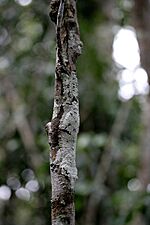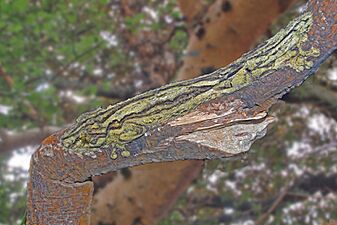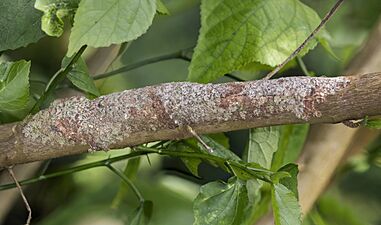Uroplatus sikorae facts for kids
Quick facts for kids Uroplatus sikorae |
|
|---|---|
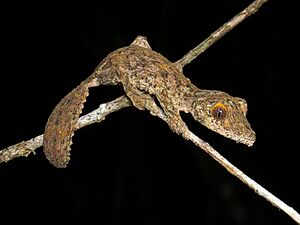 |
|
| from Vohimana Reserve, Andasibe | |
 |
|
| from Montagne d'Ambre National Park both U. sikorae |
|
| Conservation status | |
| Scientific classification | |
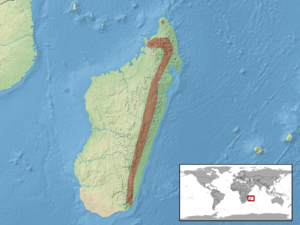 |
|
| Geographic range of U. sikorae in Madagascar | |
| Synonyms | |
|
The Uroplatus sikorae, also known as the mossy leaf-tailed gecko, is a type of lizard. It belongs to the Gekkonidae family, which includes all geckos. This amazing gecko lives only in Madagascar. It is a protected animal because its home is disappearing.
Contents
What's in a Name?
The name sikorae comes from Franz Sikora. He was an explorer from Austria. Franz Sikora studied fossils and explored Madagascar a long time ago.
About This Gecko
A German zoologist named Oskar Boettger first described this species. Its common name, "mossy leaf-tailed gecko," comes from its incredible camouflage. Its skin looks just like moss or tree bark. Scientists think there might be many more types of these geckos that haven't been discovered yet.
The Uroplatus group has 14 different species. All of them live only in Madagascar. The Uroplatus sameiti gecko used to be considered a subspecies of U. sikorae. Now, scientists consider it a separate species.
Where They Live
The mossy leaf-tailed gecko is found only on the island of Madagascar. These geckos live in the forests there. They prefer both old, untouched forests and forests that have regrown. You can find them in the eastern and central tropical forests of Madagascar.
What They Look Like
The mossy leaf-tailed gecko is usually about 6 to 8 inches (15 to 20 cm) long. This measurement is from its nose to the base of its tail. Their eyes are very large and don't have eyelids. They have yellow eyes with pupils shaped like slits. This helps them see well at night, as they are nocturnal animals.
Like all Uroplatus geckos, their tail is flat. The gecko's skin is colored to look like camouflage. They are usually grayish-brown, black, or greenish-brown. Their patterns help them blend in with tree bark, lichens, and moss.
This gecko has special skin flaps along its body, head, and limbs. These are called "dermal flaps." During the day, they press these flaps against a tree. This helps them hide by making their outline disappear. It also helps them blend in with shadows. They can even change their skin color a little bit to match their surroundings.
Life and Behavior
Mossy leaf-tailed geckos are active at night (nocturnal). They live in trees (arboreal). These geckos use their natural camouflage to hide among the trees. During the day, they hang vertically on tree trunks. They usually rest with their heads pointing down.
At night, they leave their resting spots. They go out to find food. They eat insects, spiders, and snails. Their ability to change skin color and their dermal flaps help them stay hidden.
In Captivity
It's not very common to see mossy leaf-tailed geckos as pets. When they are kept, it's often in breeding pairs or groups of three. They eat different kinds of insects that are the right size for them. This includes crickets and moths. If they breed successfully, the female gecko lays eggs every 30 days. The eggs usually hatch after about 90 days.
Dangers They Face
The biggest danger to these geckos is the loss of their home. Forests in Madagascar are being cut down (deforestation). People also collect these geckos to sell as pets. The World Wide Fund for Nature (WWF) has listed all Uroplatus species as threatened. They are on a list of animals endangered by illegal wildlife trade. This is because they are being caught and sold too much. The Uroplatus sikorae is a protected animal under CITES Appendix 2.



